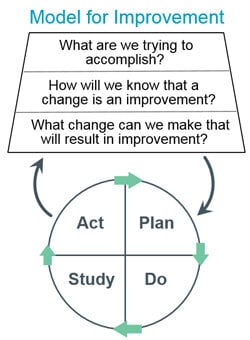Start improving with Life QI today
Full access to all Life QI features and a support team excited to help you. Quality improvement has never been easier.

Organisation already using Life QI?
Sign-up

The model for improvement (or MFI) is one of the most popular Quality Improvement (QI) models in use in healthcare settings today. Described by the Institute for Healthcare Improvement (IHI) as a ‘simple but powerful tool for improvement,’ it is a scientific method which was originally developed for the manufacturing industry.
The model has not been designed to replace models that you or your organisation might be already using, rather to speed up improvement, and help you to develop and implement improvement changes.
The model for improvement is a proven and successful method that is in use across the globe to improve healthcare processes and outcomes. The model for improvement was originally developed in around 1996 by the Association for Process Improvement (API) - a partner organisation of the IHI.
After the model for improvement was published in ‘The Improvement Guide’ it was adopted by the IHI, who went on to encourage its use in healthcare settings. Today, it now also known as the ‘IHI model’ or the Plan-Do-Study-Act (PDSA) method, as the API expanded the popular PDSA cycle - a four-step model for improvement - in order to create the model.

Let’s have a look in more detail…
The model for improvement is used across QI teams with the specific aim of helping you solve problems. If you are thinking about using the model for improvement within your QI team, let’s drill down into the detail and find out how the model for improvement actually works and the thinking behind it.
Essentially, the model has two parts – the “thinking” part and the “doing” part.
In this, the first part, you will need to first evaluate the problem you are looking at by asking three key questions:
When defining what it is exactly that you want to achieve within your QI project, it is helpful to construct an Aim Statement. By writing down an Aim Statement, and setting out exactly what you want to achieve, you will ensure that everyone is pulling in the same direction and that effort is directed in the right area.
As a minimum, an aim statement should be time-specific and measurable. Find out more about how to construct a good aim statement.
By setting appropriate quantitative measures you can find out whether things have improved within your project and whether a specific change has led to an improvement. There are three different types of measurement, which are: Outcome, Process and Balancing. You can read more in our blog about different types of improvement measures.
As there are likely to be many changes that could be made to improve a process or system, this is a really good question to ask your team, and will help identify specific, practical changes that could be readily tested – i.e. Change Ideas (or sometimes known as Interventions).
Some change ideas will be tested in the next phase of the model for improvement method, using the PDSA cycle approach.
The second part of the model for improvement process involves testing, implementing and spreading changes using the Plan Do Study Act (PDSA) cycle.
The PDSA is a four-step model for improvement, which can be used to provide a framework for quality improvement changes. It is commonly used to test if a change is an improvement – and encourages you to learn from each small test and refine to work out how to implement on a broader scale.
You can read in more detail about PDSAs in our blog.
As part of the model for improvement process involves the PDSA process – it is really valuable to be able to measure progress across your QI team. This is where a QI technology solution such as Life QI can really help.
Using Life QI, you can measure impact and scale on a regular basis with very little effort and it will help you to run, organise and measure all your improvement work in one place. Many healthcare organisations use solutions such as Life QI to help measure impact and run PDSAs, among other things.
Along with Lean and Six Sigma, the model for improvement is one of the most widely used improvement method in healthcare, and its simple approach provides real benefits.
While supporting both simple and complex improvement, the model it easy to use and implement. The use of PDSAs also means that changes can be both easily implemented, while improvements can be easily sustained.
The wide range of benefits of the model for improvement include:
To summarise, the model for improvement is a tried and tested method, recommended by the IHI and used by healthcare organisations across the globe – and is well worth investigating when setting out on your QI journey!
The Improvement Guide: A Practical Approach to Enhancing Organizational Performance. G. Langley, K. Nolan, T. Nolan, C. Norman, L. Provost. Jossey-Bass Publishers., San Francisco, 1996.
Scoville R, Little K. Comparing Lean and Quality Improvement. IHI White Paper. Cambridge, Massachusetts: Institute for Healthcare Improvement; 2014. (Available at ihi.org)
Full access to all Life QI features and a support team excited to help you. Quality improvement has never been easier.

Organisation already using Life QI?
Sign-up